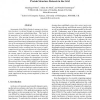BIBE
2003
IEEE
14 years 9 months ago
2003
IEEE
The tertiary (3D) structure of a protein contains the essential information for understanding the biological function of the protein at the molecular and cellular levels. Traditio...
ICDM
2005
IEEE
14 years 9 months ago
2005
IEEE
The most suitable method for the automated classification of protein structures remains an open problem in computational biology. In order to classify a protein structure with an...
DASFAA
2005
IEEE
14 years 9 months ago
2005
IEEE
A novel approach for similarity search on the protein structure databases is proposed. PADS (Protein Alignment by Directional shape Signatures) incorporates the three dimensional ...
CSB
2005
IEEE
14 years 9 months ago
2005
IEEE
Our paper describes the first provably-efficient algorithm for determining protein structures de novo, solely from experimental data. We show how the global nature of a certain ...
CIBCB
2006
IEEE
14 years 9 months ago
2006
IEEE
- Sliding window based methods are relatively often applied in prediction of various aspects related to protein structure. Despite their wide spread use, researchers did not establ...
LION
2009
Springer
14 years 10 months ago
2009
Springer
We present a new knowledge-based Model Quality Assessment Program (MQAP) at the residue level which evaluates single protein structure models. We use a tree representation of the ...
CEC
2009
IEEE
14 years 10 months ago
2009
IEEE
— Automatic protein structure predictors use the notion of energy to guide the search towards good candidate structures. The energy functions used by the state-of-the-art predict...
CBMS
2009
IEEE
14 years 10 months ago
2009
IEEE
Assessment of the (Multi) Similarity among a set of protein structures is achieved through an ensemble of protein structure comparison methods/algorithms. This leads to the genera...


